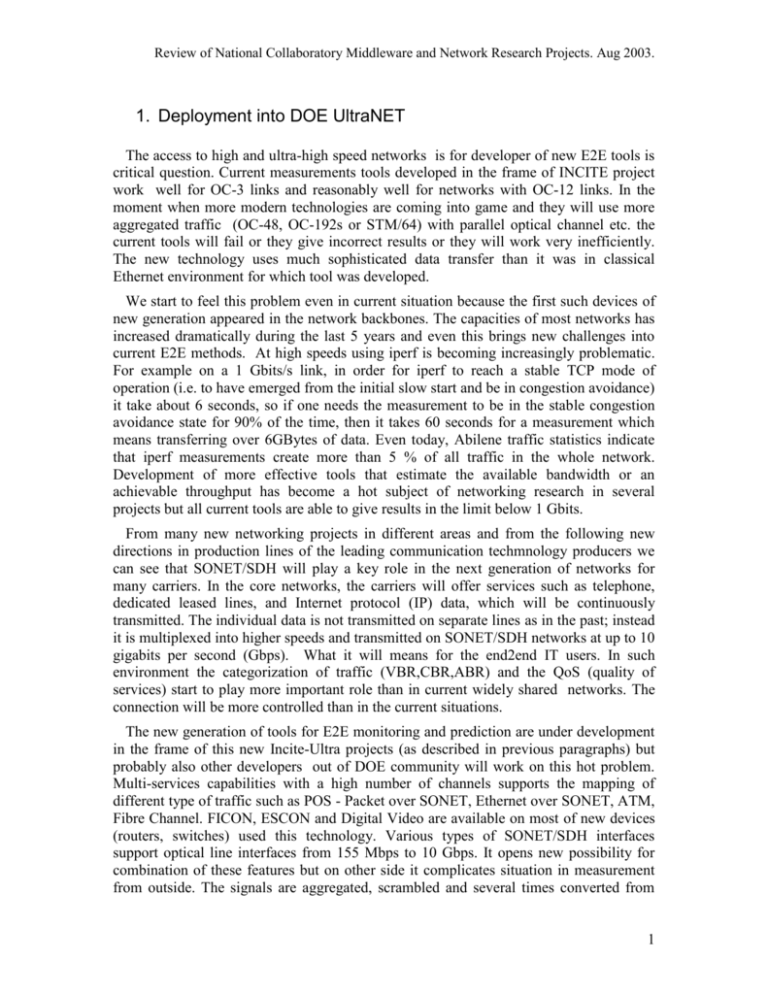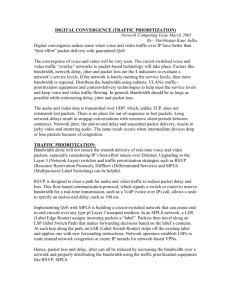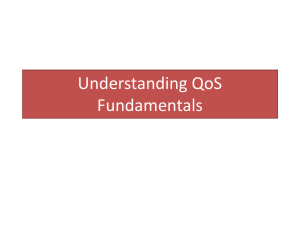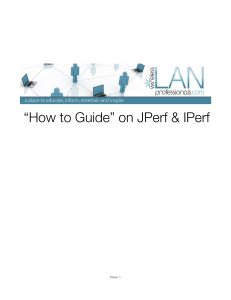ultra-items
advertisement

Review of National Collaboratory Middleware and Network Research Projects. Aug 2003. 1. Deployment into DOE UltraNET The access to high and ultra-high speed networks is for developer of new E2E tools is critical question. Current measurements tools developed in the frame of INCITE project work well for OC-3 links and reasonably well for networks with OC-12 links. In the moment when more modern technologies are coming into game and they will use more aggregated traffic (OC-48, OC-192s or STM/64) with parallel optical channel etc. the current tools will fail or they give incorrect results or they will work very inefficiently. The new technology uses much sophisticated data transfer than it was in classical Ethernet environment for which tool was developed. We start to feel this problem even in current situation because the first such devices of new generation appeared in the network backbones. The capacities of most networks has increased dramatically during the last 5 years and even this brings new challenges into current E2E methods. At high speeds using iperf is becoming increasingly problematic. For example on a 1 Gbits/s link, in order for iperf to reach a stable TCP mode of operation (i.e. to have emerged from the initial slow start and be in congestion avoidance) it take about 6 seconds, so if one needs the measurement to be in the stable congestion avoidance state for 90% of the time, then it takes 60 seconds for a measurement which means transferring over 6GBytes of data. Even today, Abilene traffic statistics indicate that iperf measurements create more than 5 % of all traffic in the whole network. Development of more effective tools that estimate the available bandwidth or an achievable throughput has become a hot subject of networking research in several projects but all current tools are able to give results in the limit below 1 Gbits. From many new networking projects in different areas and from the following new directions in production lines of the leading communication techmnology producers we can see that SONET/SDH will play a key role in the next generation of networks for many carriers. In the core networks, the carriers will offer services such as telephone, dedicated leased lines, and Internet protocol (IP) data, which will be continuously transmitted. The individual data is not transmitted on separate lines as in the past; instead it is multiplexed into higher speeds and transmitted on SONET/SDH networks at up to 10 gigabits per second (Gbps). What it will means for the end2end IT users. In such environment the categorization of traffic (VBR,CBR,ABR) and the QoS (quality of services) start to play more important role than in current widely shared networks. The connection will be more controlled than in the current situations. The new generation of tools for E2E monitoring and prediction are under development in the frame of this new Incite-Ultra projects (as described in previous paragraphs) but probably also other developers out of DOE community will work on this hot problem. Multi-services capabilities with a high number of channels supports the mapping of different type of traffic such as POS - Packet over SONET, Ethernet over SONET, ATM, Fibre Channel. FICON, ESCON and Digital Video are available on most of new devices (routers, switches) used this technology. Various types of SONET/SDH interfaces support optical line interfaces from 155 Mbps to 10 Gbps. It opens new possibility for combination of these features but on other side it complicates situation in measurement from outside. The signals are aggregated, scrambled and several times converted from 1 Review of National Collaboratory Middleware and Network Research Projects. Aug 2003. serial to parallel forms and so finally all timing effects which played role in timedispersion measurements methods are lost or they give only partial results. Also “bruteforce” methods are becoming totally inefficient because to fill high and ultra high capacity lines (over 1 Gigabit) from ordinary user machine is very difficult. And in most cases impossible. These points are only part of the reasons why new tools for E2E measurements should be developed and deployed in special measurement centers which will publish information for whole “users community”. New methods for tracking user packets in such heavily aggregated environment should be developed. We made our first experiences with this technology during our tests performed in collaboration with CERN and Caltech in the frame of DataTAG project and also during setting experimental 10 Gbps links for “Bandwidth challenge” on sc2003 and we discovered first differences compare to the existing technology which should be studied and tested in more detail in a new experimental network. 2. Study of dynamic characteristics of the traffic with respect to the relations between available bandwidth and RTT, available bandwith and achievable bandwith and its relation to real data moving applications. The study will cover different wide area networking paths with concentration on end2end on high and ultrahigh speed paths. Most of current system using Iperf measurement as a principal method for class of measurements which we call “bandwidth” measurement. In reality this is just substitutional measurement of throughput. And there is no direct answer or formula which can cover an relation between the Iperf results and the value what the real data moving application as ftp, gridftp can achieve. There are also other methods for measurements capacity of the line, available bandwidth on the path based on other techniques (udp transfer, packet dispersion etc.) Unfortunately, there is no the study which will study the relation between these results in the frame of large networks. In the past several studies has benn made where the RTT played key role for measurements and network behaviour prediction. Our preliminary research shows that RTT in high performance network is relatively stable and we can see changes only when saturation starts to play role. It very very coarse indicator but reliable indicator of network problems or structural changes There are no two identical tools and even if the authors declare that they measure some of these networking parameters (as capacity or available bandwidth), they are measuring or number of transferred packets/per time unit or time dispersion of two or more packets and trying find an relation to desired variable. The first type of measurement is measurement of throughput and in some circumstances (according parameters setup) the results can be considered as achievable bandwidth measurement. Where is the limit of this is not very clear. In each case such methods load internet with many Mbytes of probing packets and so they temporary can destabilize the situation in the critical points of the network. The second methods are pure artificially done based on practical experiences and some simulation studies. These results are mostly classified as 2 Review of National Collaboratory Middleware and Network Research Projects. Aug 2003. the methods for estimation of available bandwidth measurements. They are very light and non intrusive for the user traffic. There is also the third type of measurements which is the mixture of both previous described principles. It in reality uses the first types style of measurement (packets/time) but the stream of probing packets sending via internet is controlled by dispersion time, so finally they doesn’t load the internet so heavily as “brute force tools”. The study should find the answer on the fact under which condition we can believe to the measurements results etc. and if we can estimate from one type of measurements the results of other types. The reason for this is motivated by the fact that intrusive methods cannot be run very often on other side the light-tools based on dispersion techniques can monitor network permanently. Even if the results are sometimes quite different – specially in the extreme situations (when the networks are running close to the saturation) both methods can be very useful indicator of the behaviour of the network. We believe that only combination of several measured factors can be predicted new behavior of the network. Currently, we are monitoring more than 50 sites all over the world in the project called IEPM. We are running our “INCITE” developed tools in PLANET-LAB network where we are monitoring 30 sites, in different part of the world (US, Canada, Europe, Japan, China, Brazil). We have access to DATAtag testbed network where we have access to the nodes connected via the latest network technology (STM64). Our current developed tools will be part of the infrastructe for European Grid monitoring tool (MonAliza) and MapCenter. We are preparing our monitoring tools for IPv6 nentworks. We will be a part of the ULTRA-NET where will have a chance to monitor connection between endnodes in DEO sites. 3











